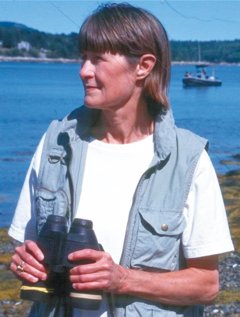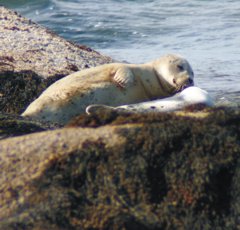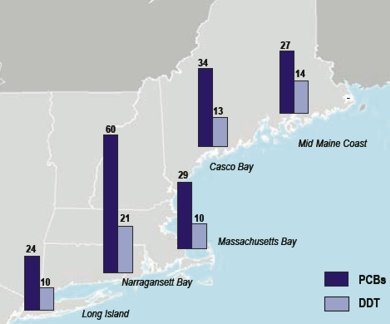
Q&A: Susan Shaw, Explorers Club Fellow and MERI Founder
Seals serve as sentinels of environmental distress
Printer Friendly Page
By Lori Valigra
 |
PHOTO: KEN WOISARD/MERI |
Susan Shaw knows a lot about overexposure, both as a photographer and a marine toxicologist focused on mammals. She first became aware of the dangers of toxic chemicals while working in the darkroom at Columbia University, where she earned a Master of Fine Arts degree in film. After working in film and photography for a decade, she went on to earn a Masters and Doctoral degree in Public Health/Environmental Health Sciences at Columbia, concentrating on the effects of toxic chemicals on people and animals.
Because of her unique background in toxicology and photography, famed nature photographer Ansel Adams contacted her in the early 1980s while she still was studying at Columbia and commissioned her to write a book on the health hazards of photographic chemicals. The result was Overexposure, published in 1983 by Adams' organization, The Friends of Photography. The book changed how individual photographers worked with darkroom chemicals and ultimately changed the field of photography.
While seeking a topic for her doctoral thesis, she spent a summer in Maine and became intrigued with a seal colony she saw on a coastal island. At around the same time there was a massive die-off from a virus of some 20,000 seals in the North Sea, the Dutch Wadden Sea, and throughout the Baltic. The hypothesis was that the seals' immune systems had been surpressed by the high levels of polychlorinated biphenyls (PCBs) in their bodies, making them susceptible to disease. The deadly chemicals get stored in the fat of seals and stay in their bodies for decades. However, there was no proof of cause and effect between the PCBs in their bodies and the deaths, so she decided to concentrate on that problem in her thesis. She subsequently moved to Maine, and in 1990 she founded the nonprofit Marine Environmental Research Institute (MERI) in Blue Hill, Maine, which conducts scientific research and education on the impacts of pollution on marine life.
Her pioneering work documenting the worldwide distribution of persistent organic pollutants in the ocean environment and their impacts on marine mammals and humans earned her a unique honor recently: she was named a Fellow of The Explorers Club. The club promotes scientific exploration of land, sea, air, and space by supporting research. Its members include Sir Edmund Hillary, Jane Goodall, Neil Armstrong, Robert Ballard, Sylvia Earle, and Dian Fossey.
Dr. Shaw recently was awarded a 2007 Gulf of Maine Council visionary award. She recently talked to the Gulf of Maine Times about her work with marine animals and toxins.
Q: What inspired you to study the impact of chemicals in the marine environment?
A: The 1998 die-off of the 20,000 European harbor seals, which was the largest wildlife signal event on record, occurred at the beginning with my doctoral thesis work at Columbia. Since then, my professional career has been focused on investigating the effects of persistent organic pollutants (POPs), including PCBs, pesticides, and more recently the brominated flame retardant chemicals in seals along the Pacific and Atlantic coasts. Flame retardants are additives in many household items, including clothing, textiles, hair dryers, furniture, computer casings, and electronic wiring. Regulating these persistent, bioaccumulative, and toxic chemicals is an urgent priority for the United States and the world.
 |
PHOTO: CYNTHIA STROUD
|
Q: Why did you chose seals as indicators of chemicals in the environment?
A: For almost two decades, I have been fascinated and somewhat haunted by the concept of sentinel species - wildlife species that signal distress as a result of exposure to unacceptable levels of man-made chemicals in the environment. Historically, the role of the sentinel was to keep watch and give advanced warning of approaching danger. Now our sentinels are seals, and they are warning about the dangers of the mounting numbers of chemicals winding up in the ocean food web. The idea of wildlife sentinels was first articulated in the 1960s by Rachel Carson, who revealed the devastating effects of DDT (dichloro-diphenyl-trichloroethane, the first modern pesticide) on bird populations, which suffered brain problems and egg shell thinning. Carson also brought to broad public attention the fact that everything in nature is interconnected, and the chemical-induced disruption of one link in the food chain ultimately affects species at the top. Her courage as a woman scientist to publically challenge the widespread use of DDT and other chemicals that were considered miracles of 1950s science inspired a generation of younger scientists, including myself.
Q: You became the first marine scientist recently to document brominated flame retardants in Gulf of Maine seals. What's your biggest concern?
A: The presence of brominated flame retardants or polybrominated diphenyl ethers (PBDEs) in our harbor seals is of particular concern because we have new evidence that they are accumulating Deca-BDE, the commercial flame retardant product still in use, and breaking it down into more toxic forms that may pose a risk to their health. Deca-BDE is used widely globally in plastic casings for computers and TVs, wires and cables, and textiles and upholstery. Harbor seals, because they are at the top of the food chain and inhabit more contaminated near-shore environments, tend to accumulate high levels of PBDEs and other fat-soluble organic compounds in their tissues through their fish diet. Although their effects in marine mammals are unknown, recent studies have linked flame retardants with immune suppression in harbor porpoises from the North and Baltic Seas and thyroid hormone alterations in young gray seals from United Kingdom waters. Our recent study revealed that PBDE levels in seals from the northwestern Atlantic are similar and in some cases higher than levels in seals inhabiting polluted European waters.
 |
CHART: COURTESY OF MERI |
Q: Will you conduct further studies of PBDEs and other chemicals?
A: To understand how seals are accumulating PBDEs through the food chain, I currently am conducting a new study with collaborators from the Gulf of Maine and Hamburg, Germany. The objective of the Food Chain Study is to analyze a broad range of organic pollutants including PDBEs in the seals' major prey fish. The study is relevant to human health since we, like seals, are at the top of the ocean food chain and most of the seals' prey fish - hake, haddock, cod, flounder, herring, and plaice (flatfish) - also are commonly eaten by people. It is unrealistic to predict health effects based on single chemicals, which is the basis of most of our calculations for health risks; this results in an underestimation of actual risk. Today, people and marine mammals are carrying hundreds of different toxic chemicals in their tissues. For example, in our harbor seal blubber samples we also found more than 100 different PCBs, dioxins and furans, DDTs, chlordane's, lindane, hexachloro-benzene, mirex, dieldrin, and many other chlorinated pesticides. In the same samples we detected 21 different PBDE compounds, and in the liver from the same animals we found another large group of organic chemicals, the perfluorinated hydrocarbons that are used in fire-fighting foams. Many of these chemicals can have additive or synergistic effects, and thousands of new ones are being released that have not been studied.
Q: You recently were appointed a fellow of the exclusive Explorers Club. How will you benefit from it?
A: My interest in joining the Explorers Club is to broaden my connections and share scientific knowledge with other like-minded individuals working in similar and related fields. It is my belief that these kinds of broad-based connections and collaborations are extremely important to finding solutions to complex problems facing the world.
Being a fellow is an honor. Of the club's 3,000 members worldwide, only 15 percent are fellows. There are no specific duties involved. A fellow must have made “significant contributions to scientific knowledge in the field of geographical exploration or allied sciences.” Fellows are invited to participate in the club's activities, and they are invited to lecture about their work. I'm involved with the New York branch of the club. Women have only been admitted since 1981 and now make up about 20 percent of the membership. I am especially pleased to be honored as a woman scientist working on the problem of global pollution.
Q: Do you have any advice for young women scientists?
A: It seems there is a trend now where women are getting into the higher levels of science, but few achieve leadership positions in academia or elsewhere. The world needs women scientists who are also leaders -- scientists who have a vision and achieve their goals in pursuit of that vision. My message is: build your knowledge base and you can open any doors you want. Science is a journey of exploration, of discovery. It is not only an exciting process, but it is critical to our understanding of life on this planet and how it can be sustained for future generations. Be sure to follow your true beliefs and interests. Advance in your field and show your leadership, because you are needed.
For more information on MERI's research, call (207) 374-2135, email info@meriresearch.org, or visit www.meriresearch.org. Dr. Shaw can be reached at sshaw@meriresearch.org.
© 2007 The Gulf of Maine Times